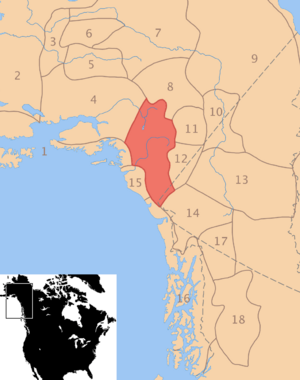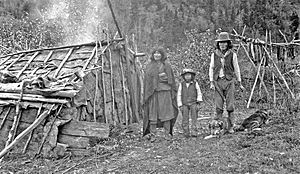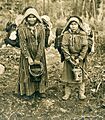Ahtna facts for kids
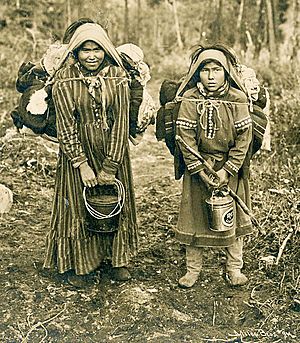
Chief Stickwan's two daughters holding buckets and carrying burdens on backs with trumplines, Klutina-Copper Center band of Lower Ahtna, 1903
|
|
| Total population | |
|---|---|
| 1,427 | |
| Regions with significant populations | |
| United States (Alaska) | |
| Languages | |
| Ahtna, English | |
| Related ethnic groups | |
| other Athabaskan peoples |
The Ahtna are an Alaska Native group of people. They are part of the larger Athabaskan family. The Ahtna people live in their homeland called Atna Nenn. This area is in the Copper River region of southern Alaska. The name Ahtna comes from the local name for the Copper River itself. Today, there are about 1,427 Ahtna people.
They live near other groups who speak similar languages. These neighbors include the Denaʼina, Koyukon, Tanana peoples, Southern Tutchone, Tlingit, Eyak, and Chugach Sugpiaq.
Contents
What's in a Name?
The name Ahtena (also spelled Ahtna or Atnatana) means "ice people." Sometimes, the Ahtna were called Copper Indians. This is because their homeland is in the area around the Copper River in southeastern Alaska. The Ahtna word for the Copper River is 'Atna' tuu" (where "tuu" means water). So, "Ahtna" means "People of the 'Atna' River," or the Copper River. Another group, the Yellowknives, were also called Copper Indians. This can sometimes cause confusion.
Ahtna Language
The Ahtna people speak a language from the Athabaskan languages family. They are part of the Subarctic cultural area. This means they are both Athabaskan and Subarctic Indians. The way people speak Ahtna can be a little different depending on where they live along the Copper River.
- The Lower Ahtna live near the river's mouth, close to the Gulf of Alaska.
- The Middle Ahtna live further up the river.
- The Upper Ahtna live on the highest parts of the river.
The Denaʼina people, who live to the west, speak a language that is very similar to Ahtna. Today, about 80 Ahtna people still speak their traditional language. To help keep the language alive, a dictionary was created in 1990 by a language expert named James Kari. Later, the Ahtna people themselves published their own dictionary of Ahtna words.
Ahtna History
Early Beginnings
About 2,000 years ago, the Ahtna people moved into the area around the Wrangell Mountains and the Chitina Valley. Even before that, their ancestors lived in the Upper and Middle Susitna area about 7,000 years ago.
Contact with Europeans
In 1781, Russians arrived at the mouth of the Copper River. Over the years, the Russians tried to travel up the river. However, the Ahtna people always pushed them back. In 1819, the Russians built a trading post where the Copper and Chitina Rivers meet, but the Ahtna people destroyed it.
Later History
The United States bought Alaska from Russia in 1867. In 1885, a U.S. military group led by Henry Tureman Allen explored the Copper River and the surrounding areas.
Ahtna Communities Today
The Ahtna people have four main language groups and eight historic bands. In 1971, the Alaska Native Claims Settlement Act (ANCSA) was passed. To benefit from this act, the Ahtna formed a company called Ahtna, Incorporated. This company manages the land they received under ANCSA. They were given 714,240 acres of land. This land includes eight villages:
- Lower (Copper River) Ahtna (Atna Hwt'aene / Atnahwt'aene)
- Native Village of Chitina (Tsedi Ná)
- Native Village of Kluti Kaah (Tl’aticae’e or Tl‟atii Na‟), also known as Copper Center.
- Central Ahtna or Middle Ahtna (Dan'ehwt'aene)
- Native Village of Gulkana (C'uul C'ena')
- Native Village of Gakona (Ggax Kuna')
- Western Ahtna (Tsaay Hwt'aene / Dze Ta Hwt'aene)
- Native Village of Tazlina (Tezdlen Na')
- Native Village of Cantwell (Yidateni Na')
- Upper (Copper River) Ahtna (Tatl'a Hwt'aene / Taa’tl’aa Denaé)
- Cheesh-Na Tribe (Tsiis Tl’edze' Caegge)
- Native Village of Mentasta (Mendaesde)
Ahtna Culture
Leadership
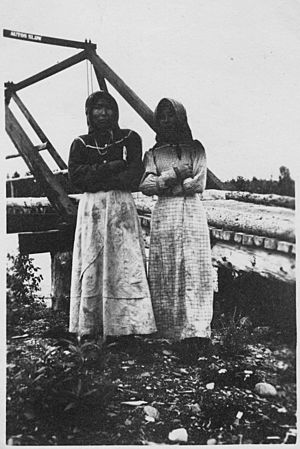
The Ahtna people have traditional leaders called chiefs. These chiefs often have special names that describe their role or the place they are from. For example, some names might mean "Person of Where Spruce Stands in Water" or "Person of Shallows Lake." These names show a strong connection to their land and history.
Homes and Buildings
In the summer, the Ahtna used temporary rectangular homes. These were made from spruce and cottonwood trees. They had bark-covered sides and entrances covered with animal skins. In the winter, families lived in larger homes built partly underground. These winter homes could be as big as 10 feet wide and 36 feet long. They were made of wood and covered with spruce bark. Sometimes, a second room was added for sweating rituals.
Daily Life and Travel
When traveling by water, the Ahtna used boats made from moose hide. In winter, they used snowshoes to walk over snow and toboggans to carry heavy loads. When people traveled on foot and carried things, especially women, they used a tool called a tumpline. A tumpline was made of animal skin or cloth. It was placed across the forehead or chest to help support a heavy load carried on the back.
Food and Hunting
Traditionally, the Ahtna hunted many animals. These included moose, caribou, mountain sheep, and rabbits. Salmon was a very important food. They caught salmon with nets in rivers and streams. To make sure there were enough animals to hunt, the Ahtna would watch and control the number of predators like wolves, eagles, and bears. For example, they would keep track of wolf dens in their hunting areas. The Ahtna also gathered berries and roots for food.
Trade and Economy
Historically, the Ahtna were part of a trading network. They traded with other Athabaskan groups, the Alutiiq, and the Tlingit. They traded furs, animal hides, and copper. After meeting Europeans, they also traded for manufactured European goods. Trade meetings often happened three times a year at Nuchek on the Prince William Sound.
Today, the Ahtna people operate Ahtna, Inc. This company was founded in 1971. Ahtna, Inc. provides various services. For example, one of their companies, Ahtna Technical Services (ATS), has provided services to government agencies since at least 2008.
See also
- List of Native American peoples in the United States
Images for kids


